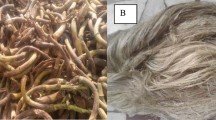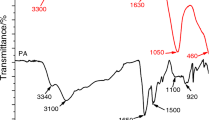Abstract
Light-weight and fire safety are crucial requirements for fiber-reinforced polymer composites used in mainly the logistics sector. Phosphorus-based FR agents can be one of the effective solutions to improve the flame retardancy properties of highly flammable poly(butylene terephthalate) (PBT) and its composites reinforcing with various high-performance fibers. In this perspective, the purpose of this study was to see how microencapsulated red phosphorus (mRP) affected the flame retardancy of a chopped basalt fiber (BF)-reinforced PBT composite. The composite samples were manufactured with the constant amount of BF (20 mass%) and mRP concentrations ranging from 5 to 20% by mass. A synergistic study between the mRP (14 mass%) and a neat TiO2 (1 mass%) was also carried out. The TGA, cone calorimeter, LOI, and UL-94 V tests were used to characterize samples. Char residues of composites were analyzed via the ATR-FT-IR and SEM inspections. Test results released that the HRR values of PBT matrix and BF-reinforced PBT composite decrease while the char formation and the LOI values steadily increased with the incorporation of mRP. Remarkable decreases in fire performance parameters were observed between 23 and 55% while the highest residue (35.0%) were achieved with the mRP concentration of 20 mass%. The increment in LOI at about 50% and a V0 rating in the UL-94 V test were obtained when the added amount of mRP reached to 20 mass%. A synergism was seen between the mRP and TiO2 in the condensed phase considering the results of MLC test.
Graphical abstract






Similar content being viewed by others
References
Yang W, Yang B, Lu H, Song L, Hu Y. Effect of modified carbon nanotube on the thermal behavior, flame retardancy and mechanical properties of poly(1,4-butylene terephthalate)/aluminum phosphinate composites. Ind Eng Chem Res. 2014;53(48):18489–96. https://doi.org/10.1021/ie503039e.
Gallo E, Braun U, Schartel B, Russo P, Acierno D. Halogen-free flame retarded poly(butylene terephthalate) (PBT) using metal oxides/PBT nanocomposites in combination with aluminium phosphinate. Polym Degrad Stab. 2009;94(8):1245–53. https://doi.org/10.1016/j.polymdegradstab.2009.04.014.
Braun U, Schartel B. Flame retardancy mechanisms of aluminium phosphinate in combination with melamine cyanurate in glass-fibre-reinforced poly(1,4-butylene terephthalate). Macromol Mater Eng. 2008;293(3):206–17. https://doi.org/10.1002/mame.200700330.
Brehme S, Köppl T, Schartel B, Altstädt V. Competition in aluminium phosphinate-based halogen-free flame retardancy of poly(butylene terephthalate) and its glass-fibre composites. E-Polymers. 2014;14(3):193–208. https://doi.org/10.1515/epoly-2014-0029.
Vothi H, Nguyen C, Pham LH, Kim J, Hoang D. Degradation mechanism and flame retardancy of aluminum phosphonate in glass fiber-reinforced poly(butylene terephthalate). Polym Bull. 2020;78(12):6761–76. https://doi.org/10.1007/s00289-020-03455-2.
Köppl T, Brehme S, Wolff-Fabris F, Altstädt V, Schartel B, Döring M. Structure−property relationships of halogen-free flame-retarded poly(butylene terephthalate) and glass fiber reinforced PBT. J Appl Polym Sci. 2012;124(1):9–18. https://doi.org/10.1002/app.34910.
Louisy J, Bourbigot S, Duquesne S, Desbois P, König A, Klatt M. Novel synergists for flame retarded glass-fiber reinforced poly(1,4-butylene terephthalate). Polimery. 2013;58(5):403–12.
Han X, Zhao J, Liu S, Yuan Y. Performance improvement of flame-retarded poly(butylene terephthalate)/aluminum diethylphosphinate composites by epoxy-functional polysiloxane. High Perform Polym. 2014;27(6):742–8. https://doi.org/10.1177/0954008314559553.
Yang W, Song L, Hu Y, Lu H, Yuen RKK. Investigations of thermal degradation behavior and fire performance of halogen-free flame retardant poly(1,4-butylene terephthalate) composites. J Appl Polym Sci. 2011;122(3):1480–8. https://doi.org/10.1002/app.34119.
Yang W, Hu Y, Tai Q, Lu H, Song L, Yuen RKK. Fire and mechanical performance of nanoclay reinforced glass-fiber/PBT composites containing aluminum hypophosphite particles. Compos A Appl Sci Manuf. 2011;42(7):794–800. https://doi.org/10.1016/j.compositesa.2011.03.009.
Qi Y, Wu W, Liu X, Qu H, Xu J. Preparation and characterization of aluminum hypophosphite/reduced graphene oxide hybrid material as a flame retardant additive for PBT. Fire Mater. 2017;41(3):195–208. https://doi.org/10.1002/fam.2382.
Liu P, Liu M, Gao C, Wang F, Ding Y, Wen B, et al. Preparation, characterization and properties of a halogen-free phosphorous flame-retarded poly(butylene terephthalate) composite based on a DOPO derivative. J Appl Polym Sci. 2013;130(2):1301–7. https://doi.org/10.1002/app.39318.
Köppl T, Brehme S, Pospiech D, Fischer O, Wolff-Fabris F, Altstädt V, et al. Influence of polymeric flame retardants based on phosphorus-containing polyesters on morphology and material characteristics of poly(butylene terephthalate). J Appl Polym Sci. 2013;128(5):3315–24. https://doi.org/10.1002/app.38520.
Chen L, Luo Y, Hu Z, Lin G-P, Zhao B, Wang Y-Z. An efficient halogen-free flame retardant for glass-fibre-reinforced poly(butylene terephthalate). Polym Degrad Stab. 2012;97(2):158–65. https://doi.org/10.1016/j.polymdegradstab.2011.11.003.
Courtat J, Mélis F, Taulemesse J-M, Bounor-Legaré V, Sonnier R, Ferry L, et al. Effect of phosphorous-modified silica on the flame retardancy of polybutylene terephthalate based nanocomposites. Polym Degrad Stab. 2017;143:74–84. https://doi.org/10.1016/j.polymdegradstab.2017.06.014.
Balabanovich AI, Zevaco TA, Schnabel W. Fire retardance in poly(butylene terephthalate). The effects of red phosphorus and radiation-induced cross-links. Macromol Mater Eng. 2004;289(2):181–90. https://doi.org/10.1002/mame.200300153.
Cai T, Guo F, Jian-fen C. Synergetic fire retardant effect of nano CG-ATH and red phosphorus for PBT. Polymer Mater Sci Eng. 2006;22(6):205.
Yang W, Zhang Y-R, Yuen AC-Y, Chen TB-Y, Chan M-C, Peng L-Z, et al. Synthesis of phosphorus-containing silane coupling agent for surface modification of glass fibers: Effective reinforcement and flame retardancy in poly(1,4-butylene terephthalate). Chem Eng J. 2017;321:257–67. https://doi.org/10.1016/j.cej.2017.03.123.
Keshavarzian A, Haghighi MN, Afshar Taromi F, Abedini H. Phosphorus-based flame retardant poly (butylene terephthalate): synthesis, flame retardancy and thermal behavior. Polym Degradat Stabil. 2020;180:109310. https://doi.org/10.1016/j.polymdegradstab.2020.109310.
Casu A, Camino G, De Giorgi M, Flath D, Laudi A, Morone V. Effect of glass fibres and fire retardant on the combustion behaviour of composites, glass fibres–poly(butylene terephthalate). Fire Mater. 1998;22:7–14.
Wittek T, Tanimoto T. Mechanical properties and fire retardancy of bidirectional reinforced composite based on biodegradable starch resin and basalt fibres. Express Polym Lett. 2008;2(11):810–22. https://doi.org/10.3144/expresspolymlett.2008.94.
Yang W, Jia Z, Chen Y, Zhang Y, Si J, Lu H, et al. Carbon nanotube reinforced polylactide/basalt fiber composites containing aluminium hypophosphite: thermal degradation, flame retardancy and mechanical properties. RSC Adv. 2015;5(128):105869–79. https://doi.org/10.1039/c5ra18606d.
Wu Q, Chi K, Wu Y, Lee S. Mechanical, thermal expansion, and flammability properties of co-extruded wood polymer composites with basalt fiber reinforced shells. Mater Des. 2014;60:334–42. https://doi.org/10.1016/j.matdes.2014.04.010.
Wang S, Zhong J, Gu Y, Li G, Cui J. Mechanical properties, flame retardancy, and thermal stability of basalt fiber reinforced polypropylene composites. Polym Compos. 2020;41(10):4181–91. https://doi.org/10.1002/pc.25702.
Yao D, Yin G, Bi Q, Yin X, Wang N, Wang DY. Basalt fiber modified ethylene vinyl acetate/magnesium hydroxide composites with balanced flame retardancy and improved mechanical properties. Polymers (Basel). 2020;12(9):2107. https://doi.org/10.3390/polym12092107.
Guo Y, Zhou M, Yin GZ, Kalali E, Wang N, Wang DY. Basalt fiber-based flame retardant epoxy composites: preparation, thermal properties, and flame retardancy. Mater (Basel). 2021;14(4):902. https://doi.org/10.3390/ma14040902.
Xu J, Fan J, Kang C, Niu L, Ju C. Study on mechanical properties of nano-Sb2O3/BEO-PBT flame retardant composites reinforced by surface-modified basalt fiber. J Adhes Sci Technol. 2021;36(13):1458–78. https://doi.org/10.1080/01694243.2021.1972652.
Arslan Ç, DoĞAn M. The effect of a phosphorus-based FR on the fire performance and flammability properties of basalt fiber-reinforced acrylonitrile-butadiene-styrene composites. Turk J Chem. 2022;46(5):1702–9. https://doi.org/10.55730/1300-0527.3473.
Andrzejewski J, Michalowski S. Development of a new type of flame retarded biocomposite reinforced with a biocarbon/basalt fiber system: a comparative study between poly(lactic acid) and polypropylene. Polymers (Basel). 2022;14(19):4086. https://doi.org/10.3390/polym14194086.
Green J. A review of phosphorus-containing flame retardants. J Fire Sci. 1992;10(6):470–87.
Arslan C, Dogan M. The effects of silane coupling agents on the mechanical properties of basalt fiber reinforced poly(butylene terephthalate) composites. Compos B Eng. 2018;146:145–54. https://doi.org/10.1016/j.compositesb.2018.04.023.
Arslan C, Dogan M. The mechanical and thermal properties of chopped basalt fiber-reinforced poly (butylene terephthalate) composites: Effect of fiber amount and length. J Compos Mater. 2019;53(17):2465–75. https://doi.org/10.1177/0021998319830775.
Tayfun Ü. Application of sustainable treatments to fiber surface for performance improvement of elastomeric polyurethane reinforced with basalt fiber. J Vinyl Add Tech. 2023. https://doi.org/10.1002/vnl.22000.
Fiore V, Scalici T, Di Bella G, Valenza A. A review on basalt fibre and its composites. Compos B Eng. 2015;74:74–94. https://doi.org/10.1016/j.compositesb.2014.12.034.
Andrzejewski J, Danielak A, Piasecki A, Islam A, Szostak M. Biocarbon-based sustainable reinforcing system for technical polymers. The structure-properties correlation between polycarbonate (PC) and polybutylene terephthalate (PBT)-based blends containing acrylonitrile-butadiene-styrene (ABS). Sustain Mater Technol. 2023. https://doi.org/10.1016/j.susmat.2023.e00612.
Liu YL. Flame-retardant epoxy resins from novel phosphorus-containing novolac. Polymer. 2001;42:3445–54.
Shieh J-Y, Wang C-S. Synthesis of novel fame retardant epoxy hardeners and properties of cured products. Polymer. 2001;42:7617–25.
Wu CS, Liu YL, Chiu YC, Chiu YS. Thermal stability of epoxy resins containing flame retardant components: an evaluation with thermogravimetric analysis. Polym Degrad Stab. 2002;78:41–8.
Levchik GF, Vorobyova SA, Gorbarenko VV, Levchik SV, Weil ED. Some Mechanistic Aspects of the Fire Retardant Action of Red Phosphorus in Aliphatic Nylons. J Fire Sci. 2000;18:172–82.
Schartel B, Kunze R, Neubert D. Red phosphorus-controlled decomposition for fire retardant PA 66. J Appl Polym Sci. 2002;83(10):2060–71. https://doi.org/10.1002/app.10144.
Savas LA, Deniz TK, Tayfun U, Dogan M. Effect of microcapsulated red phosphorus on flame retardant, thermal and mechanical properties of thermoplastic polyurethane composites filled with huntite&hydromagnesite mineral. Polym Degrad Stab. 2017;135:121–9. https://doi.org/10.1016/j.polymdegradstab.2016.12.001.
Xie R, Qu B, Hu K. Dynamic FTIR studies of thermo-oxidation of expandable graphite-based halogen-free fame retardant LLDPE blends. Polym Degrad Stab. 2001;72:313–21.
Wu Q, Lü J, Qu B. Preparation and characterization of microcapsulated red phosphorus and its flame-retardant mechanism in halogen-free flame retardant polyolefins. Polym Int. 2003;52(8):1326–31. https://doi.org/10.1002/pi.1115.
Granzow A, Ferrillo RG, Wilson A. The effect of elemental red phosphorus on the thermal degradation of poly(ethylene terephthalate). J Appl Polym Sci. 1977;21:1687–97.
Laoutid F, Ferry L, Lopez-Cuesta JM, Crespy A. Red phosphorus/aluminium oxide compositions as flame retardants in recycled poly(ethylene terephthalate). Polym Degrad Stab. 2003;82(2):357–63. https://doi.org/10.1016/s0141-3910(03)00213-1.
Zhou Y, Liu X, Wang F, Hao J, Du J. Effect Of Metal Oxides On Fire Resistance And Char Formation Of Intumescent Flame Retardant Coating. J Inorg Mater. 2014;29:972–8.
Chen X, Wang Y, Jiao C. Influence of TiO2 particles and APP on combustion behavior and mechanical properties of flame-retardant thermoplastic polyurethane. J Therm Anal Calorim. 2017;132(1):251–61. https://doi.org/10.1007/s10973-017-6847-6.
Pan Y-T, Castillo-Rodríguez M, Wang D-Y. Mesoporous metal oxide/pyrophosphate hybrid originated from reutilization of water treatment resin as a novel fire hazard suppressant. Mater Chem Phys. 2018;203:49–57. https://doi.org/10.1016/j.matchemphys.2017.09.040.
Kim J, Yoo S, Bae J-Y, Yun H-C, Hwang J, Kong B-S. Thermal stabilities and mechanical properties of epoxy molding compounds (EMC) containing encapsulated red phosphorous. Polym Degrad Stab. 2003;81(2):207–13. https://doi.org/10.1016/s0141-3910(03)00090-9.
Wu N, Li X. Flame retardancy and synergistic flame retardant mechanisms of acrylonitrile-butadiene-styrene composites based on aluminum hypophosphite. Polym Degrad Stab. 2014;105:265–76. https://doi.org/10.1016/j.polymdegradstab.2014.04.011.
Dang Z, Anderson BG, Amenomiya Y, Morrow BA. Silica-Supported Zirconia 1 Characterization by Infrared Spectroscopy, Temperature-Programmed Desorption, and X-ray Diffraction. The Journal of Physical Chemistry A. 1995;99:14437–43.
Efimov AM, Pogareva VG. IR absorption spectra of vitreous silica and silicate glasses: The nature of bands in the 1300 to 5000 cm−1 region. Chem Geol. 2006;229(1–3):198–217. https://doi.org/10.1016/j.chemgeo.2006.01.022.
Braun U, Balabanovich AI, Schartel B, Knoll U, Artner J, Ciesielski M, et al. Influence of the oxidation state of phosphorus on the decomposition and fire behaviour of flame-retarded epoxy resin composites. Polymer. 2006;47(26):8495–508. https://doi.org/10.1016/j.polymer.2006.10.022.
Thomas LC. Interpretation of the infrared spectra of organophosphorus compounds [by] LC Thomas. 1974.
Szolnoki B, Bocz K, Marosi G, Toldy A. Flame retardancy of sorbitol based bioepoxy via combined solid and gas phase action. Polymers (Basel). 2016;8(9):322. https://doi.org/10.3390/polym8090322.
Liang Y, Wang H, Sanchez Casalongue H, Chen Z, Dai H. TiO2 nanocrystals grown on graphene as advanced photocatalytic hybrid materials. Nano Res. 2010;3(10):701–5. https://doi.org/10.1007/s12274-010-0033-5.
Wang J, Jin C, Sun Q, Zhang Q. Fabrication of nanocrystalline anatase TiO2 in a graphene network as a bamboo coating material with enhanced photocatalytic activity and fire resistance. J Alloy Compd. 2017;702:418–26. https://doi.org/10.1016/j.jallcom.2017.01.263.
Liu Y, Wang Q. Melamine cyanurate-microencapsulated red phosphorus flame retardant unreinforced and glass fiber reinforced polyamide 66. Polym Degrad Stab. 2006;91(12):3103–9. https://doi.org/10.1016/j.polymdegradstab.2006.07.026.
Acknowledgements
This study was supported by Erciyes University Scientific Research Unit under grant no BAP-FDK-2017-7749.
Author information
Authors and Affiliations
Corresponding author
Additional information
Publisher's Note
Springer Nature remains neutral with regard to jurisdictional claims in published maps and institutional affiliations.
Rights and permissions
Springer Nature or its licensor (e.g. a society or other partner) holds exclusive rights to this article under a publishing agreement with the author(s) or other rightsholder(s); author self-archiving of the accepted manuscript version of this article is solely governed by the terms of such publishing agreement and applicable law.
About this article
Cite this article
Arslan, Ç., Doğan, M. Flame retardancy of basalt fiber-reinforced PBT composite: effect of red phosphorus and TiO2 synergism. J Therm Anal Calorim 148, 10151–10161 (2023). https://doi.org/10.1007/s10973-023-12370-3
Received:
Accepted:
Published:
Issue Date:
DOI: https://doi.org/10.1007/s10973-023-12370-3




